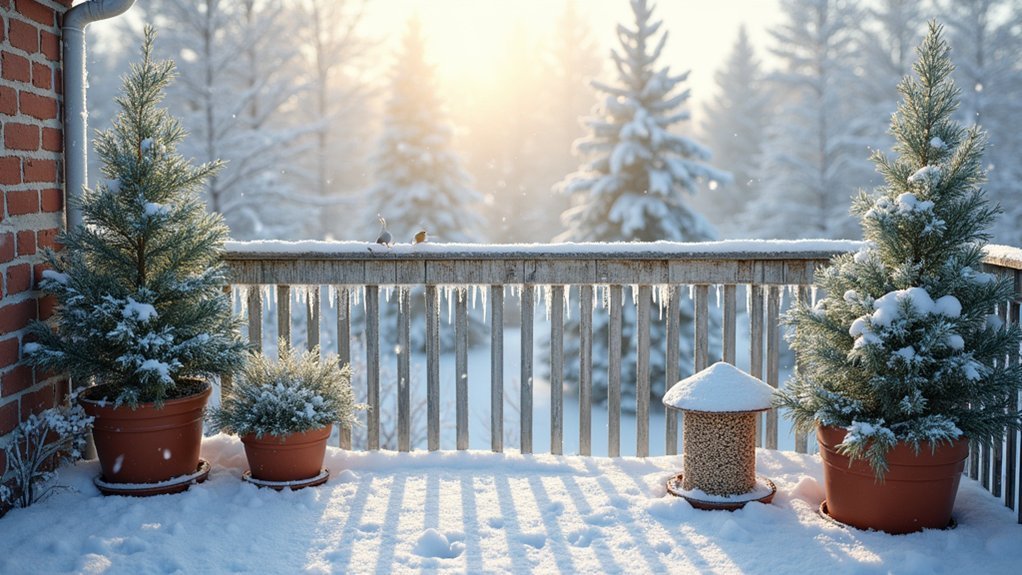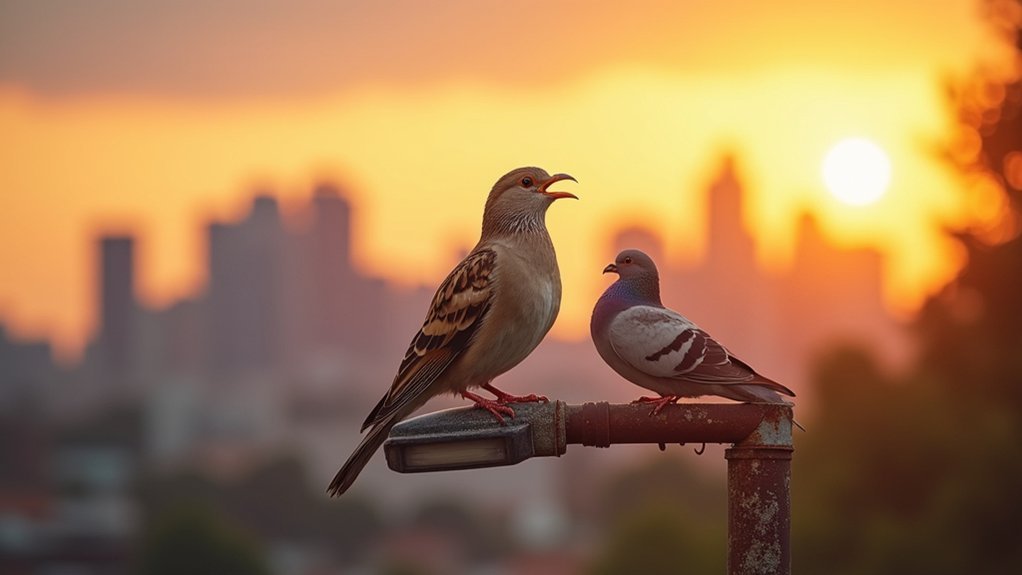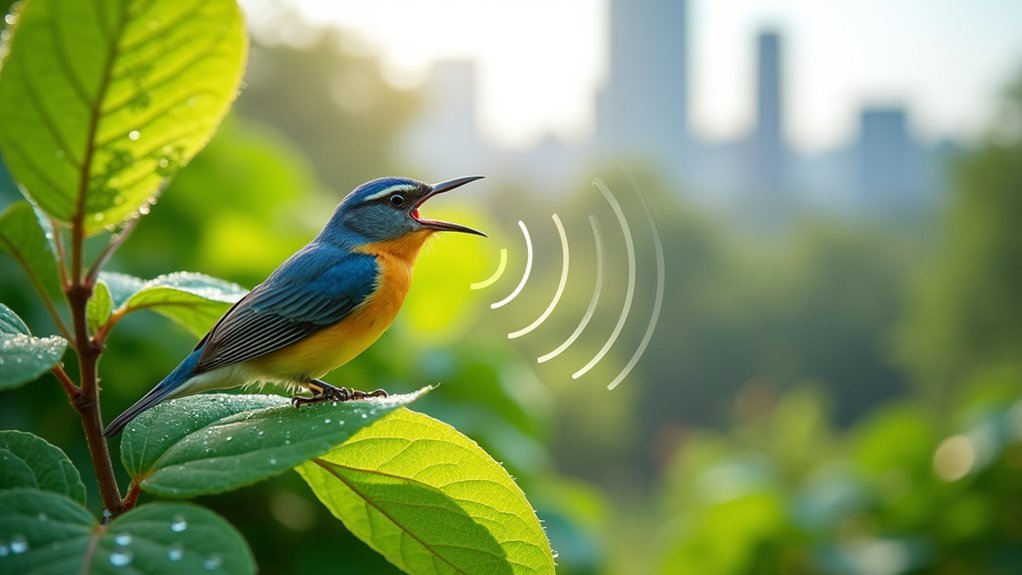Balconies make perfect winter wildlife sanctuaries because they’re easily customizable elevated spaces where you can create microhabitats with minimal effort. You can install bird feeders with high-calorie seeds, position water sources that won’t freeze, and plant hardy varieties that provide natural food and shelter. Your vertical space offers protection from ground predators while strategic arrangements of dense foliage create wind-protected nooks. These small sanctuaries become vibrant ecosystems with just a few thoughtful additions.
Essential Bird-Feeding Strategies for Winter Balcony Gardens

Why let your balcony sit dormant during winter when it could become a vibrant sanctuary for local birds? Transform your space by installing bird feeders filled with high-calorie options like black oil sunflower seeds and suet. These critical food sources sustain winter wildlife when natural offerings from native plants are scarce.
Position feeders near windows for easy observation while protecting birds from harsh winds. Opt for squirrel-proof designs to guarantee smaller songbirds can access food without competition from larger mammals.
Don’t forget to maintain your feeders by cleaning and refilling them regularly to prevent disease spread.
Complete your winter wildlife haven with a heated birdbath, providing essential water when natural sources freeze. Your balcony can offer both shelter and nourishment, creating a beneficial ecosystem for birds and beneficial insects alike.
Creating Sheltered Microhabitats in Limited Balcony Spaces
Even the smallest balcony can become a winter haven for wildlife when you strategically create microhabitats within its constraints.
Maximize vertical space by adding climbing plants and hanging baskets that provide shelter for insects while conserving valuable floor area.
Vertical gardening creates insect sanctuaries while preserving precious balcony space for other wildlife needs.
Create diverse microhabitats by arranging twigs, leaves, and rocks in corners, forming nooks where small wildlife can hide from harsh elements.
Install bee hotels with properly sized tubes to attract native cavity-nesting insects that enhance your balcony’s biodiversity.
For birds seeking winter protection, position nesting boxes in areas sheltered from strong winds.
Supplement these with pots of dense foliage and evergreen branches, creating protective resting spots.
These varied elements work together to transform your limited space into a complex sanctuary where multiple species can find refuge during challenging winter months.
Selecting Hardy Plants That Provide Winter Food Sources

While microhabitats provide shelter, the right plant selection transforms your balcony into a true winter buffet for wildlife. Choose hardy plants like conifers, holly, and winterberry that retain their berries throughout winter months, offering essential food sources when other options disappear.
Don’t overlook native grasses and seed-producers such as echinacea and ornamental grasses—their seed heads provide high-energy nutrition for birds during scarce periods.
Winter-flowering varieties like mahonia and hellebores attract pollinators with valuable nectar even in cold weather.
Plants with hollow stems, such as Cardinal lobelia, provide excellent shelter for beneficial insects while their decaying foliage feeds overwintering wildlife.
Maintaining Water Accessibility During Freezing Temperatures
When temperatures plummet below freezing, water becomes a critically scarce resource for urban wildlife, yet it remains just as essential for their survival as food.
Even in a small area like your balcony, you can provide a helping hand by installing a heated birdbath that guarantees constant access to open water.
A simple heated birdbath transforms your balcony into a winter wildlife sanctuary, offering liquid relief when nature freezes over.
For those without electrical options, place shallow dishes with pebbles in sunny spots where birds and other wildlife can safely drink without risk of drowning.
Remember to check and refill these water sources daily as they quickly evaporate or freeze.
Adding insulation around containers using foam or straw helps them stay warm longer into the evening.
Position your offerings in sheltered corners where they’re protected from harsh winds while capturing available sunlight—strategic placement notably extends their usability during winter’s harshest days.
Strategic Balcony Arrangements for Maximum Wildlife Visitation

The design and layout of your balcony greatly influence which wildlife visitors you’ll attract during winter months. Position bird feeders in visible, accessible spots where birds can safely perch while keeping watch for predators. Incorporate native shrubs in containers along the perimeter to create natural shelter and food sources.
Maximize vertical space with hanging baskets and wall-mounted planters to increase plant diversity without sacrificing floor area. This creates layered habitats that appeal to different species. Install insect hotels in sheltered corners to support beneficial invertebrates that birds feed on.
Create sheltered nooks using dense foliage arrangements that block wind while providing privacy for nervous visitors. Always keep water sources centrally located but protected from strong winds, ensuring they remain accessible when temperatures drop.
This strategic arrangement transforms even small balconies into wildlife-friendly sanctuaries.
Frequently Asked Questions
How to Turn a Balcony Into a Winter Garden?
Install hardy winter plants like hellebores, add a heated birdbath, create sheltered areas with fallen leaves, hang bird feeders with high-calorie seeds, and position containers strategically to maximize sunlight and protect from harsh winds.
Can I Turn My Balcony Into a Garden?
You can transform your balcony into a thriving garden. Use containers, vertical planters, and hanging baskets to maximize space. Choose plants suited to your climate and sunlight conditions for best results.
In Summary
Your balcony can become a lifeline for wildlife during winter’s harshest months. By implementing strategic feeding stations, creating sheltered corners, planting food-producing flora, maintaining unfrozen water sources, and arranging your space thoughtfully, you’ll transform your small outdoor area into a thriving sanctuary. You’re not just decorating a balcony—you’re creating an essential refuge that sustains local biodiversity when nature’s resources are most scarce.





Leave a Reply